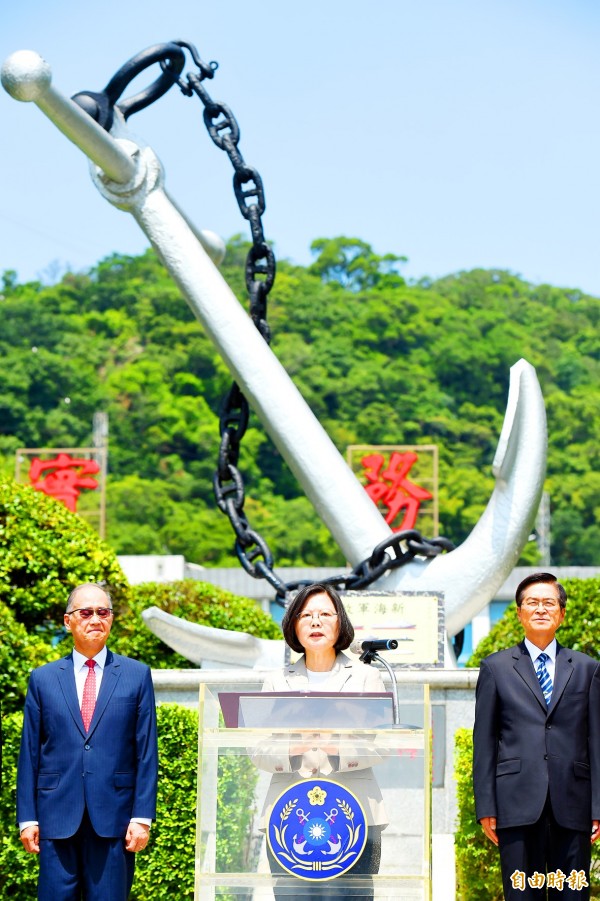《TAIPEI TIMES》 Arms development budget to soar: Tsai

President Tsai Ing-wen, center, delivers a speech yesterday at Navy Command Headquarters in Taipei, where she unveiled a plaque symbolizing the beginning of a new era for the navy as it builds its own submarines. Photo: Chu Pei-hsiung, Taipei Times
WARFARE CAPABILITY: The nation is to spend NT$73.6 billion, or 21.3 percent, of its defense budget on the development of indigenous weapons, the president said
By Lo Tien-pin and Jonathan Chin / Staff reporter, with staff writer and CNA
Taiwan will spend more than one-fifth of its defense budget next year on the development of indigenous weapons, in line with the government’s policy of strengthening national security, President Tsai Ing-wen (蔡英文) said yesterday.
In the government’s proposals for next year’s national budget, defense spending is to increase by NT$18.3 billion (US$597.5 million) from the previous year to NT$346 billion, which represents 2.16 percent of the nation’s GDP, Tsai said.
Of the total defense budget, NT$73.6 billion, or 21.3 percent, is to be spent on developing indigenous defense systems, an increase of NT$25 billion, as part of the effort to broaden the nation’s warfare capability, she said.
The proposals also include NT$95.1 billion for military investment, an increase of NT$13.9 billion from the previous year, Tsai said during the unveiling of a plaque at Navy Command Headquarters.
The plaque, which bears the inscription “New Navy Sets Sail,” symbolizes the beginning of a new era for the navy, during which it will use domestically built submarines, Tsai said, referring to the nation’s ongoing construction of defense submarines.
Since the late 1980s, when Taiwan bought two Dutch-built Zwaardvis-class diesel submarines, it has had difficulty procuring others and had been planning to build its own, Tsai said.
However, because of the challenges facing the nation, the idea got stuck until she came to office in 2016.
“Faced with such challenges, we should try to resolve them, instead of recoiling in fear,” she said.
The administration has been integrating resources from industry, academia, government and international partners to push its program forward, she said.
“Step by step, we have been making progress in resolving the bottlenecks in innovation and manufacturing,” Tsai said.
In related developments, a defense official on Sunday said that the construction costs for the first three mass-produced Tuo Jiang-class corvettes would be increased from NT$14.4 billion to NT$16.1 billion.
The navy plans to follow the class’ lead ship, the Tuo Jiang PG-618, with three anti-aircraft Flight I ships and five anti-ship and anti-submarine Flight II ships by 2025, in addition to Flight III ships whose specifications and production schedule are not yet known.
Due to adjustments to the hull design, the ships would have a projected displacement of 700 tonnes compared with the Tuo Jiang’s 567 tonnes.
Navy Command last week appointed the Chungshan Institute of Science and Technology to oversee the construction program of the three Flight I ships, which is to be implemented by select contractors, the official said on condition of anonymity.
Flight I Tuo Jiang-class corvette armaments are to consist of Tien Chien II (TC-2) surface-to-air missiles, while the Flight IIs would be a mix of Hsiung Feng II and Hsiung Feng III cruise missiles.
Additionally, the navy has made strides in the indigenous submarine program after the US Department of State in April authorized US firms to export submarine technology to Taiwan, the official said.
The granting of licenses enabled US firms to cut out intermediaries and deal with the Taiwanese government directly, the official said.
The administration has been briefed by six international corporations from the US, the EU, Japan and India in connection with their offers of technical assistance for the submarine program, the official said.
An Indian firm has invited navy officers and CSBC Corp, Taiwan (台灣國際造船) representatives to visit its facilities in-country, the official added.
新聞來源:TAIPEI TIMES















